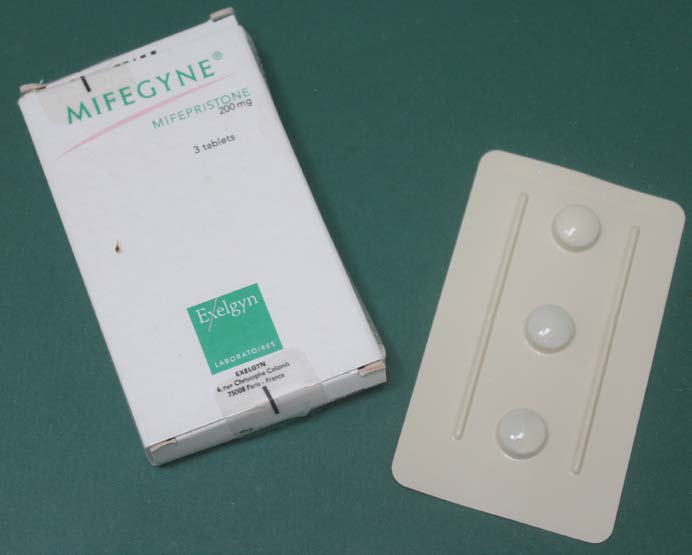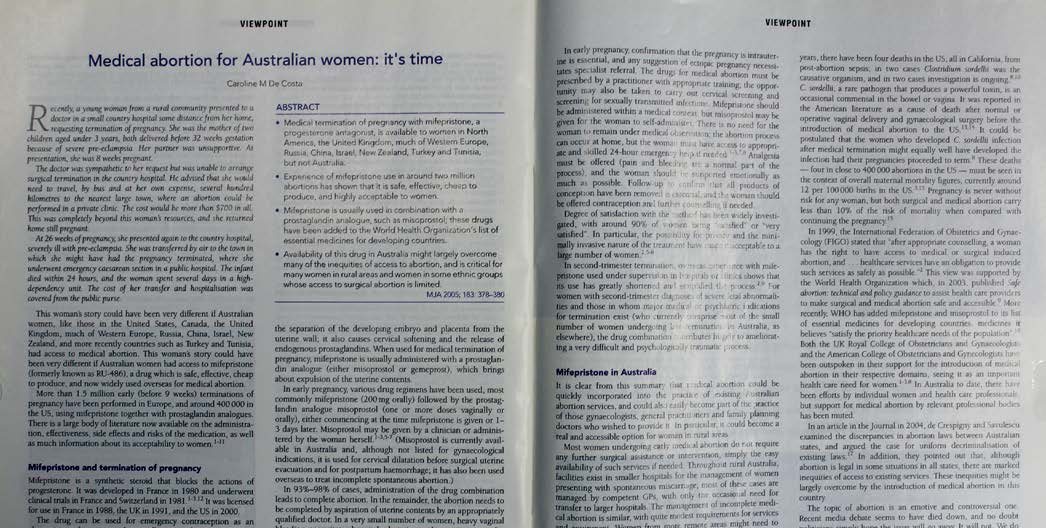In 1996, Brian Harradine was an independent Senator representing Tasmania and he held the balance of power during the first Howard government, which often needed his vote in the Upper House. That year Harradine, a staunch opponent of abortion, made a deal with Howard. Harradine agreed to support the government’s bill for the partial privatisation of Telstra in return for Howard’s amending legislation governing the Therapeutic Goods Administration (TGA), to prohibit the import, manufacture or use of the drug RU486 (mifepristone) in Australia without the special permission of the Federal Minister for Health. The ‘Harradine Amendment’ effectively made mifepristone for medical termination of pregnancy (MTOP) unavailable to Australian women.
For some years, there was muted opposition to the Amendment from the medical profession, most notably the late David Healy; politicians from all parties, but particularly the Democrats’ Lyn Allison; and pro-choice groups. However, it began to gather force in 2005. Meanwhile, in Cairns, we had become aware from Dr Adrienne Fleming of a possible loophole in the TGA legislation that might enable us to import the drug for use in private practice for the purpose of MTOP. This was the Authorised Prescriber (AP) legislation that exists to allow medical practitioners to import and use drugs registered and available overseas, but not in Australia, for serious medical conditions. We set about completing the volumes of paperwork required for AP approval from the TGA, while feeling, because of the Harradine Amendment, it was unlikely that we would gain such approval, particularly as the Minister for Health at the time was Tony Abbott, an outspoken opponent of abortion.

The first dose of mifepristone to be legally imported into Australia.
In October 2005, one of us (Caroline de Costa) published in the Medical Journal of Australia an article reviewing overseas use of mifepristone for MTOP and calling on the government to make the drug available to Australian women. Immediately, a number of politicians mostly, but not exclusively, women and from across all parties, made contact with us and there were invitations to Canberra to discuss ways to overturn the Amendment and then subsequently gain access to mifepristone in Australia. Many individual doctors and doctors’ groups, including RANZCOG, the Federal AMA and rural medicine groups, and many pro-choice groups, including Children by Choice, Reproductive Choice Australia, state Family Planning associations and others, came together in a spontaneous, but well-organised, effort to change the legislation. Get-Up also became involved in the campaign. Very quickly there was huge media interest in the whole question of medical abortion, most of it supportive of the need for change. There was also concerted opposition from anti-choice and ‘right to life’ groups. But the strong message from the proponents of change was: let the TGA decide – not the Minister for Health.
The climax of this feverish activity came in February 2006 when four Senators – Lyn Allison (Democrat), Claire Moore (ALP), Judith Troeth (Liberal) and Fiona Nash (National) – brought a private members’ bill to the Senate that was passed. That bill went a week later to the House of Representatives where it was subject to a conscience vote and also passed; the Harradine amendment was consigned to the dustbin of history.
However, the rescinding of the Amendment did not mean that the drug immediately went on sale in pharmacies across the country. In fact, no major drug company or distributor was willing to import or manufacture mifepristone in Australia. However, in Canberra, our application for AP approval for mifepristone had been quietly making its way through the echelons of the TGA and, in April 2006, we received permission to import and use the drug in Cairns. We had already established contact with colleagues in New Zealand, who had been performing MTOP since 2001, and in May 2006 we received our first batch.
We had no clinic in which to perform MTOPs so, after appropriate discussion with women requesting abortion, we administered the drug in consulting rooms in Cairns and sent the women home in the care of a support person. Aware of the media spotlight on us, we were extremely cautious in choosing patients: we gave women our mobile phone numbers and kept in contact meticulously. Soon, however, we realised what all the overseas studies had shown: mifepristone plus misoprostol used in appropriate women in the early weeks of pregnancy is a safe method of termination of pregnancy very acceptable to women themselves.
We wrote to a large number of our gynaecological colleagues urging them to make similar applications – Jan Dickinson from Perth, Chris Bayly from Melbourne and Terry McGee from Sydney were the first to do so, but for the first three years numbers were small. Then doctors from South Australia and the Marie Stopes (MS) organisation also gained AP approval, and numbers of MTOPs in Australia increased rapidly. In 2012, the drug got full TGA approval for distribution by MS Health and in 2013 PBS listing. From 2009 onwards, the Sexual Health Clinic in Cairns Hospital, under Dr Darren Russell, also provided MTOP, which gave strong support for our efforts.

The opinion piece that started the ball rolling.
What was it like for us in those early years? We certainly received much media attention, almost all of it well-informed and well-presented. We received a considerable amount of (anonymous) hate mail that, as advised by Cairns police, we placed in a special file, handling it as little as possible to conserve the writers’ fingerprints!
However, for every piece of negative mail there were ten messages of support. At one stage there was a stalker, eggs were thrown and trees ring-barked on our personal properties and police protection was provided. The stalker told the Cairns Post that he intended to ‘run us out of town’. This brought a huge outpouring of support for us in the Post from our fellow citizens and the stalker moved on to other targets.
In August 2005, we sat on the veranda of Mike’s house in Cairns and wondered if we were mad to make the TGA application – surely it would never be approved! By August 2006, the Amendment had been overturned and we were providing mifepristone to Cairns women. This was thanks to the efforts of thousands of people right across Australia. We were pleased and proud to have been part of this movement.







Leave a Reply